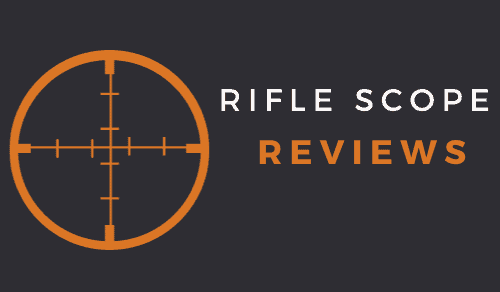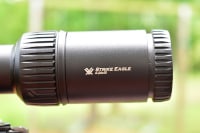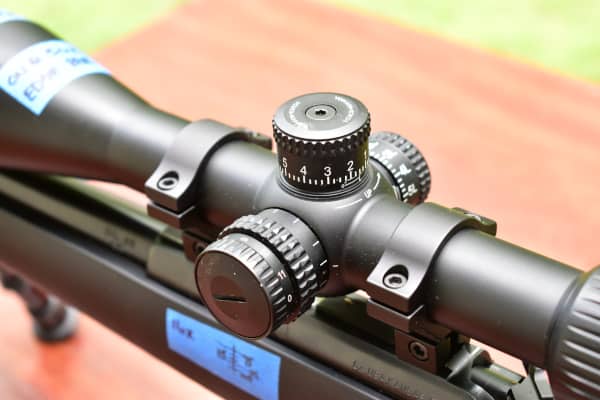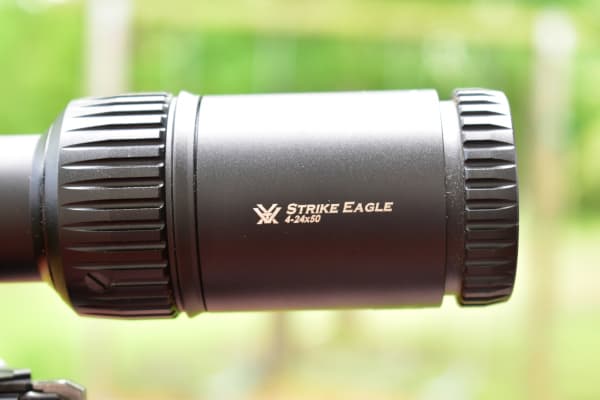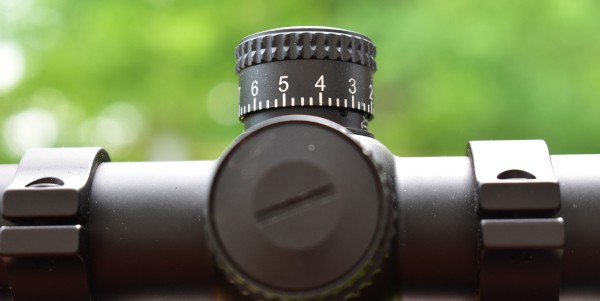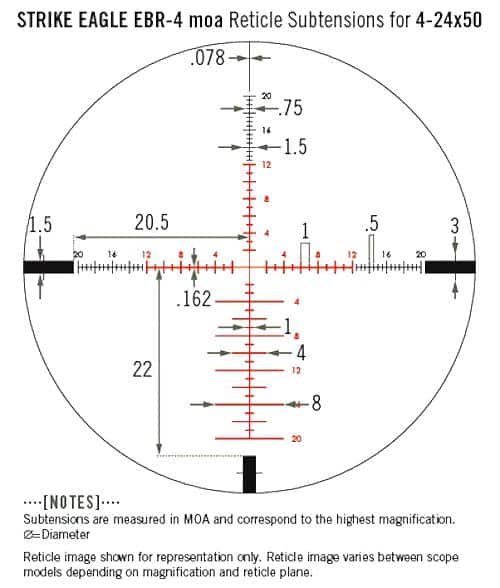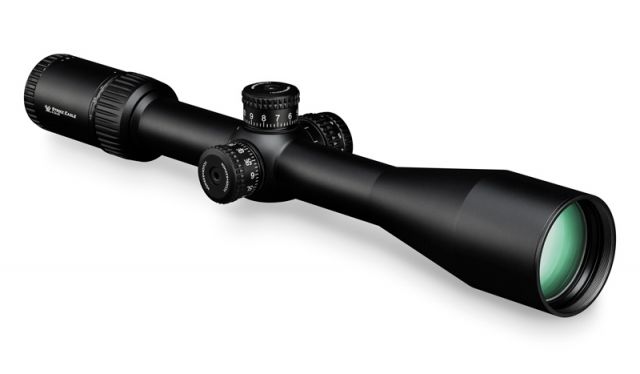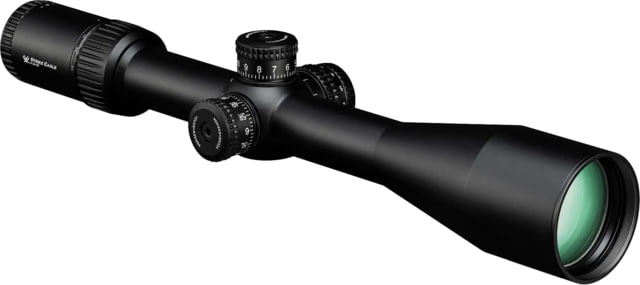As an Amazon Associate I earn from qualifying purchases. Amazon and the Amazon logo are trademarks of Amazon.com, Inc, or its affiliates.
I own a few of the Vortex Strike Eagle scopes in the 4-24×50 configuration and have them mounted on different rifles for different uses. One is mounted on a 22LR rifle that I use for squirrel hunting, and the other is mounted on a 17 HMR rifle that I use for long-range plinking and some hunting. Ever since I showed a few pics of those scopes on the blog, I’ve been receiving question after question about those Strike Eagle 4-24 scopes. So based on the questions, I thought it might make sense to do a complete Vortex Strike Eagle 4-24×50 review.
Vortex Strike Eagle 4-24×50 Background
The Strike Eagle line of scopes was first introduced by Vortex at the beginning of 2015. The first Strike Eagle scope was a 1-6×24 model made for the AR platform. In 2017, Vortex added a 1-8×24 model that was also geared towards the AR platform.
At the beginning of 2018, Vortex added two more models to the Strike Eagle family, a 3-18×44 model and a 4-24x50mm model. These two scope models could be used for precision-based long-range shooting with an AR but were more versatile than the lower powered Strike Eagle scopes as they could tackle short-range, mid-range, and longer-range shooting as needed.
At the end of 2019, Vortex officially phased out the 3-18 and 4-24 Strike Eagle series. Those models were removed from the Vortex website or marked as being “limited distribution” models. Just a little heads up about Vortex, anytime a product is marked as “limited distribution,” it’s being phased out of production or discontinued. Later in this article, I’ll touch on why I think the 4-24 and 3-18 models were discontinued.
Within Vortex’s hierarchy of scopes, the Strike Eagle series is one step above the Diamondback and Diamondback HD scopes series but one step below the Vortex Viper scope series.
Technical Specs
This Vortex 4-24×50 Strike Eagle scope is built on a 30mm tube manufactured from aircraft-grade aluminum. The scope is O-ring sealed and nitrogen purged to eliminate internal condensation and fogging.
Here are the technical specifications for the 4-24 version straight from the Vortex website:
Magnification: 4-24x
Objective Lens Diameter: 50 mm
Eye Relief: 3.5 inches
Field of View: 26.2-4.3 ft/100 yds
Tube Size: 30 mm
Turret Style: Tactical
Adjustment Graduation: 1/4 MOA
Travel Per Rotation: 12 MOA
Max Elevation Adjustment: 80 MOA
Max Windage Adjustment: 80 MOA
Parallax Setting: 20 yards to infinity
Length: 14.9 inches
Weight: 25.6 oz
Overview
When doing reviews of rifle scopes, I usually try to adhere to the following topics and specifications:
- Magnification Range
- Optical Quality
- Focal Plane
- Side Focus
- Parallax Range
- Operational Controls
- Warranty
- Scope Weight
- Vortex EBR-4 Reticle
- Country of Manufacture
Let’s go over each of these topics in more detail:
Magnification Range
As previously mentioned, this particular Strike Eagle scope comes in a 4-24 magnification range. Personally, I like this power range because it’s incredibly versatile. The 4x low end is low enough for short-range shooting, especially with a side focus that will focus down to 20 yards. And, the upper magnification range in the 20x to 24x, is more than enough magnification for most long distance shooting scenarios.
If you’ve read any other parts of this site, then you may have already know that I prefer higher magnification scope options over lower ones because I’d rather have the magnification and not need it versus not have it and really need it.
That being said, if you feel that the 4-24 is too much power for your personal uses, then consider the Strike Eagle model in the 3-18×44 range.
Optical Quality
Optical quality is always a complex topic to assess because there are so many variables and opinions that come into play when trying to define lens quality, brightness, and clarity.
To be clear, I’ve always felt that it was essential to have realistic expectations of optical quality based on price points or cost. The optical quality is almost always tied to cost as you can and do get what you pay for with lens quality. With riflescopes, it’s the one aspect where better glass generally equates to a higher cost. Very rarely will a $400 scope have glass equal to a higher-end scope costing two or three times as much.
With that being said, for the money (and I’ll get more into the costs of this scope later), I’d rate the optics on this scope to be better than average for a Chinese-made optic. Of course, the glass clarity isn’t going to compete with a Meopta, a Nightforce, or a higher-end Leupold, but it shouldn’t, as this Strike Eagle costs about a ¼ as much as either of those brands typical scope models.
The optical clarity is better than average, but there is some distortion around the edges. That distortion is most noticeable at the higher powers, like the 20x to 24x ranges.
This model isn’t the brightest scope I’ve tested at this price point, but it’s about average for a rifle scope in this price range.
The color quality is slightly off (which seems somewhat common on Chinese-made glass) but not to the point where targets appear incorrectly colored or odd-looking. For example, white target paper appears to have a very slight yellowish tint to it through the glass on this scope.
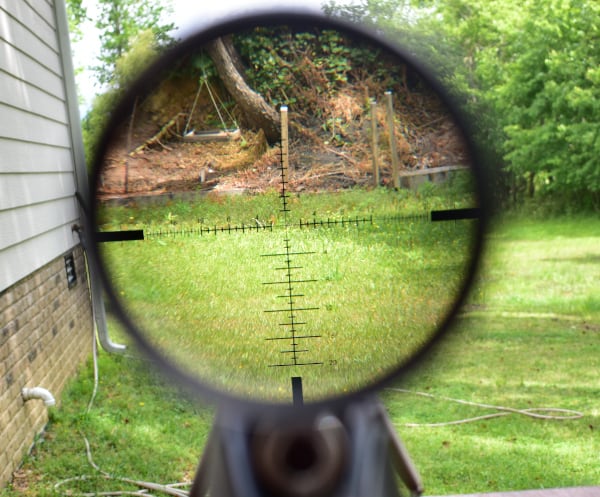
I use one of my 4-24 Strike Eagles for hunting purposes, and the prairie dogs and squirrels appear to be the correct color through the scope in the field, so it’s never been a huge issue for me.
Focal Plane
The 4-24 Strike Eagle scope is a second focal plane (SFP) model, so the reticle stays the same size as the power magnification increases or decreases. This fixed reticle size differs from a first focal plane model where the reticle size changes as the power magnification increases or decreases.
If you aren’t familiar with the differences between the focal planes, here’s a link to another article I posted on the FFP vs SFP debate.
Since I predominantly use these Strike Eagle scopes for hunting purposes, I’m perfectly happy with the SFP design. However, if you were shopping for a dedicated scope for nothing but long-range shooting, you may want to consider an FFP model. The 3-18×44 Strike Eagle scope is also a second focal plane model.
To be clear and avoid any confusion, in 2020, Vortex introduced another Strike Eagle scope model in a 5-25×56 configuration. As this model is designed for long-range shooting, it’s a first focal plane (FFP) model.
Side Focus
When it comes to adjusting the focus or parallax adjustment on a scope, there are usually two types of adjustment positions on riflescopes:
- Adjustable objective
- Side Focus
With an adjustable objective, the scope focus or parallax is adjusted by turning the objective unit. With a side focus feature, the side focus adjustment knob is mounted on the left side of the scope where the turrets are located.
I own and use riflescopes with adjustable objectives and side focus. Between the two specific positions, I prefer the side focus option as I find it easier to adjust without coming out of the scope. Technically speaking, one can adjust an adjustable objective without leaving the scope as well, but I find it to be more difficult.
The adjustable objective design is becoming less common as more and more scope makers are switching over to the side focus design.
This 4-24 Vortex Strike Eagle scope is equipped with a side focus feature that also has an integrated illumination power control built-in.
The side focus on this model can be a bit difficult to turn when it’s brand new, but it loosens up with use.
Parallax Range
Technically, parallax and side focus is basically the same function, but I listed parallax as a separate topic because I wanted to focus on the parallax distance or range.
Any scope with an adjustable parallax or focus option will have a minimum distance that they can focus down to; this distance is usually measured in yards. They will also have a maximum distance for focus, and most scopes use infinity as the max focus distance.
This 4-24 Vortex scope is built with a parallax that will adjust down to 20 yards. While that may not seem beneficial to some shooters, it can be incredibly helpful when shooting at targets at distances of 50 yards or closer.
This side focus setting allows the shooter to adjust the scope focus at a target as close as 20 yards. Of course, if you’re shooting at targets at longer distances, that feature may not be helpful. But, if you’re using the scope for hunting purposes, it can be invaluable. This short-range parallax is especially helpful in situations where a game target shows up at close range.
I run one of these 4-24 Strike Eagle scopes on a 22LR rifle set up for squirrel hunting. I find the short minimum focusing capability very helpful when a squirrel pops up on a log 30 yards away. Then, before taking the shot, I can adjust the side focus down until the squirrel is nice and clear in the glass.
Operational Controls
Operational controls is a fancy word for buttons and knobs on the scope. While some of the controls, like the power adjustment ring and the side focus adjustment, are initially tight, they loosen up with time and become smooth as butter.
The turrets move smoothly and feature an audible and tactile click, so it’s very easy to see, hear, and feel the turret adjustments, and I like that. I’m not a fan of mushy turrets that don’t produce any noise as they are being adjusted.
If I had one complaint with the controls, it would be the size of the text distance markings on the side focus. They are a bit small and can be challenging to read for a guy like me with bad vision. However, it doesn’t take long to learn the focus positions. These days, I can turn the side focus to a specific distance without even looking at the adjustment knob.
Warranty
As with most of the well-known brands of riflescopes, I believe that it’s always worthwhile to discuss the warranty. If you don’t care about the warranty, feel free to skip this section.
This scope is fully covered by the Vortex lifetime warranty, even though this riflescope model has been discontinued. Unfortunately, some shoppers get confused about that and mistakenly believe that Vortex won’t honor the warranty on a product that is no longer in production or no longer offered for sale. That simply is not the case. Vortex honors the warranty on all their products regardless of the age or when it was manufactured.
There is one caveat to discuss with the warranty, and it specifically has to do with Vortex’s warranty service on a scope that has been discontinued. If you send in a discontinued Vortex scope for warranty, they will undoubtedly try to repair it.
However, if they cannot repair it or if the parts to fix it are no longer available, Vortex will typically offer you a replacement scope that is as close in value or level of performance to the discontinued model you sent in for repair. If that approach doesn’t work for you, they will usually offer you a healthy in-store credit towards another model you wanted.
Scope Weight
Riflescope weight is always an interesting topic, and it only seems to become relevant when the scope is on the heavier side. Well, this Strike Eagle scope weighs in at 25.6 ounces, which translates to 1.6 pounds.
25.6 ounces isn’t the heaviest scope I’ve tested or owned, but it’s not exactly a lightweight model either.
If you’re thinking about this scope for a bench gun or you primarily shoot from the bench, then the weight usually is not an issue.
However, if you’re shopping for a hunting scope, then weight may be a factor in the buying decision. With scope rings, this piece of glass will weigh in around 28 to 29 ounces, which is only a couple of ounces shy of 2 pounds. So, an 8-pound rifle now becomes a 10-pound set-up with glass. I bring this up as it’s something to take into consideration when scope shopping.
Each person has their own preferences and perceptions of weight, so a 10-pound rifle may be no big deal to one hunter and way too heavy for another.
For my uses and preferences, the weight of this scope is not an issue.
Vortex EBR-4 Reticle
Originally, this 4-24 version of the Strike Eagle was only available with one reticle option, and that’s Vortex’s EBR-4 reticle. However, in 2022, Vortex opted to release a model to certain vendors that featured an EBR-4 MRAD reticle.
The EBR-4 MOA reticle is a glass-etched, illuminated reticle designed for long-distance shooting and ranging. When used properly, the EBR-4 can be used to:
- Range targets in the field (I prefer a rangefinder)
- Determine holdovers
- Be used to compensate for windage corrections
Being an MOA-based reticle, the reticle is “true” at the highest magnification, which is 24x.
Initially, I was concerned that this reticle might be a little bit too busy for hunting applications, but that concern was unfounded as I find this reticle to perform exceptionally well for my hunting purposes.
The hash marks are small enough for use on even the smallest targets, and the illuminated reticle is handy for low-light shooting.
A quick word about illuminated reticles: Typically, shooters and hunters fall into one of three categories regarding illuminated reticles:
- They hate them with a passion
- They love them
- They could care less about illumination
I believe that illumination can have its place with reticles and prefer to have the lighted reticle capability if needed. I’d have to say that I’ve been able to harvest several squirrels, prairie dogs, and groundhogs with this reticle in low light situations that probably would not have been possible without the illumination feature.
If you’re not a fan of the illumination features on the EBR-4 but like the reticle otherwise, consider removing the CR2032 battery to disable the illumination functionality.
Country of Manufacture
Where an optic is manufactured or produced can be a hot topic of debate, so I always try to address the Country of Origin if possible.
I’ve already mentioned it a few times above, but this Strike Eagle 4-24 model is manufactured at a sporting optics plant in China.
Vortex engineers layout the scope specifications, but the actual scope is built in the People’s Republic of China.
For some people, the made-in-China aspect will be a deal-breaker, and I understand that approach as I prefer to buy American made anytime I can.
However, in the scope industry, there are very few optic brands that manufacture their optics in the United States anymore. Even long-time US-based brands like Leupold use lenses that are sourced from other countries.
Why Was it Discontinued?
Answering the question about why the Strike Eagle 4-24 model (and 3-18 model) were discontinued or phased out is tough. I’ve posed the question to various individuals within the Vortex company and received a few different answers.
The answer that seems to make the most sense is that Vortex encountered an issue sourcing the specific glass used on the 4-24 and 3-18 scopes. Therefore, rather than switch lenses during the middle of the product lifespan, they opted to discontinue these models.
Plus, I think was some confusion with these higher-powered scope models being included in the Strike Eagle scope family when this series was best known for lower-powered AR-based scopes.
Where to Buy
One of the more common questions I get when reviewing scopes is either “would you buy this scope yourself?” or “would you buy this scope again?”. So let me answer those questions:
When Vortex first introduced this scope, it had a $699 MSRP and sold in stores for $599 to $625.
To be honest, at that price, I don’t think this scope was all that great of a deal, especially when you could get one of the Vortex Viper scopes for another $50 to $100.
Even though Vortex has stopped producing this scope, there are still a few large Vortex distributors who have a supply of the 4-24 models in stock and are offering them for sale at a fairly steep discount.
At a discounted price of less than $400, I wouldn’t hesitate to buy another Strike Eagle scope in 4-24 power again (if I needed another one).
Here are a few places that I found who still have some of these Strike Eagle models in 3-18 or 4-24 in stock and on sale:
FAQS
Can you compare the Vortex Viper vs Strike Eagle?
The Strike Eagle series of scopes is one step down in the current hierarchy of Vortex optics. The Vortex Viper 6.5-20×50 PA scope has slightly better optics than the Strike Eagle scopes and is available in different reticle options, including a Mil-Dot reticle or Dead-Hold BDC reticle.
The turrets on the Viper are capped, while the comparable Strike Eagle turrets are exposed tactical-style turrets.
While both scope models have side focus, the Viper only focuses down to a minimum of 50 yards, where the Strike Eagle will focus down to 20 yards.
The Viper weighs about 4 ounces less than the Strike Eagle 4-24 and about 2 ounces less than the Strike Eagle 3-18 model.
Can you compare the Vortex Viper PST vs Strike Eagle scopes?
The Vortex Viper PST scopes (especially the Gen II models) are several models above the Strike Eagle scopes in the Vortex hierarchy of scope models.
The optical quality on the Viper PST and PST Gen II scopes is significantly better than the optical quality on the Strike Eagle scopes. However, that makes sense as the PST models have an MSRP cost of at least 2x the Strike Eagle scopes when they were being offered at a full $699 MSRP.
The Viper PST scopes are available in FFP and SFP configurations, where the Strike Eagle 4-24 was only offered in an SFP version.
The one area where the PST and higher-powered Strike Eagle scopes are similar is the reticle option. Both scope series is available with the EBR-4 reticle.
While both scope versions share many features and functionality, the PST optical quality and cost are well above those found with the Strike Eagle scopes.
Can you compare the Vortex Crossfire ii vs Strike Eagle scopes?
Within the Vortex family of riflescopes, the Strike Eagle models are positioned about two levels above the Crossfire II series in terms of features and function.
The optical quality on the higher-powered Strike Eagle scopes is marginally better than the Crossfire II higher power scope models, but the Crossfire II models come at a lower price point.
Where the Strike Eagle 4-24 is only available in a 30mm tube, the higher-powered Crossfire II scope models are offered in both a 1-inch tube and 30mm versions.
The Strike Eagle 4-24 scope will focus down to a minimum distance of 20 yards, but the higher power Crossfire II models like the 6-24×50 and 6-18×40 scopes will focus down to 10 yards.
The Strike Eagle scope is only available with the Vortex EBR-4 reticle. In comparison, the 6-24 and 6-18 versions of the Crossfire II scopes are available with more reticle options, including the Vortex Dead-Hold BDC, V-Plex, and V-Brite reticles.
Has the Strike Eagle 4-24×50 been discontinued?
I briefly touched on this topic previously, but Vortex did discontinue the Vortex Strike Eagle scopes in 4-24 and 3-18 configurations at the end of 2019 with no plans to re-introduce these models.
Is the Vortex Strike Eagle 4-24×50 scope worth the money?
I briefly discussed this above, but I would definitely say that the this version of the Vortex Strike Eagle is worth the money if you can find one for sale under $400. In my opinion, the scope isn’t all that great of a deal at full MSRP.
Is the Vortex Strike Eagle 4-24×50 scope waterproof and fogproof?
Like most all the Vortex optics, the 4-24×50 Strike Eagle is completely waterproof and fogproof. It is designed to withstand various weather conditions without compromising its performance.
Does the Vortex Strike Eagle 4-24×50 scope come with a mount?
No, this version of the Strike Eagle does not come with a mount. You will need to purchase a mount separately based on your rifle’s requirements.
Is the Vortex Strike Eagle 4-24×50 scope compatible with .308 or 6.5 Creedmoor rifles?
The 4-24 Strike Eagle is compatible with both .308 and 6.5 Creedmoor rifles, although the optic is not available with a dedicated .308 or 6.5 Creedmoor ballistic reticle. This optic is designed to handle the recoil and performance of these calibers.
If I come across any new information on this topic, I’ll update this page.
I’ve been working in the firearms and sporting optics industry for over 20 years, with a personal and professional interest in all things related to rifle scopes, Through a combination of work experience, formal training, and personal experiences, I have extensive experience mounting, testing, and evaluating different rifle scope models across most major optical brands.
